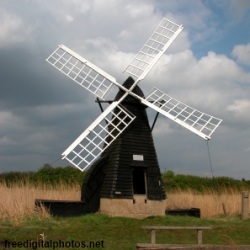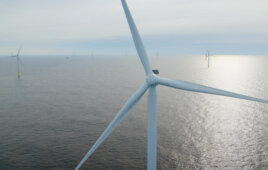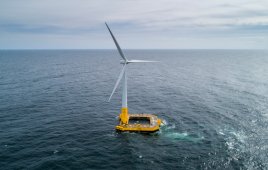 There is more to the windpower industry than kilowatt-hours. For instance, the first recorded windmills come from — where else — China, in about 200 BC. Here are a few other wind energy facts to share:
There is more to the windpower industry than kilowatt-hours. For instance, the first recorded windmills come from — where else — China, in about 200 BC. Here are a few other wind energy facts to share:
- Wind is the natural movement of air, but many don’t know it is caused by the Earth’s surface being unevenly heated by the sun. Thank you solar energy!
- Some of the first documented uses for wind energy sailed boats along the Nile River around 5,000 BC. China was using basic windmills for water pumping by 200 BC.
- Other early documented windmills were also designed for grain grinding before 900 AD in Persia. The vertical-axis windmills had a central shaft with vertical sails made of wood and reeds.
- Charles F. Brush was the first inventor to build a large-scale wind energy turbine for electricity generation around 1888 (just 23 years after the civil war) in Cleveland, Ohio. Weighing 40 tons, it stood 60 ft. tall with a 56 ft. diameter. The multi-bladed rotor was able to power his mansion with 12kW that charged 12 batteries. The windmill was also the first to incorporate a step-up gearbox.
- In 1931, Russia started developing a utility-scale 100-kW wind energy generator. They say it produced about 200,000 kWh near the shore of the Caspian Sea.
- Windpower grew in popularity with the unstable fossil fuels market in the 1970s. This sparked a global interest in wind turbines for power generation. Thank you fossil fuels!
- The Baltic Sea marks the location of the first commercial offshore wind farm. Installed in 1991 about 2 km. off the coastline of Vindeby, Denmark, the 11-turbine wind farm has been in operation for more than 20 years setting the expectations for many offshore projects.
Filed Under: Offshore wind, Turbines





This article is somewhat full of it.
The known history of wind energy, is as follows:
1.) 3000 years ago in ancient Persia, all the draft animals had died off due to climate change (global warming which created the Sahara desert from a green landscape). The ancient Persians then applied the dead animals’ skins to frames they built on the same type of merry-go-round draft-wheels that the live animals had pushed, letting the wind push the wheels in a circle instead of the animals. A wall was built to block the wind on one side.
LINK:
http://aigooalexyz.wordpress.com/2011/01/31/five-environmental-discoveries-that-originated-in-the-middle-east/
2) 2000 years ago, wind energy imitated sailboat technology, transitioned to triangular sails moving across the wind. Examples abounded in the Greek Islands.
LINKS:
http://www.redbubble.com/people/slavicab/works/9600899-greek-island-patmos-windmills-photography
http://www.touristmaker.com/images/zakynthos/windmill-zakynthos-greece.jpg
2.5) ~1200 years ago the Chinese had a few largely unproductive designs that went nowhere. Some used flapping reed mats, and none played a role in the progress of wind energy.
3) 1000 years ago, Europeans added a frame behind the cloth to lend an airfoil shape to the sails, lengthened the sails to create high-aspect-ratio blades, added the automated ability to aim, overspeed protection, as well as fire-supression systems and a gearbox.
3.5) 150 years ago: High-solidity, many-bladed, torque-based turbines were developed for pumping water. Charles Brush built a huge one with hundreds of blades, but it produced only a small fraction of the power it should have, due to using a water-pumping-type rotor for generating electricity. To this day, anyone trying to use a water-pumping windmill to run a generator will be disappointed.
4) 100 years ago someone in Denmark got the first modern (low-solidity, high-speed rotor) electricity-generating wind turbine working. The key to generating electricity is speed. The key to speed is low rotor-solidity.
5) 70 years ago a MegaWatt scale turbine was installed and operated on Grandpa’s Knob, Vermont. It quickly broke down.
6) 40 Years ago the Danes combined non-pitching blades with an induction motor and gearbox to yield the first reliable large-scale wind turbines able to be deployed in large numbers to generate electricity on an industrial scale. The key was simplicity.
7) Since then blades pitching and more sophisticated generators and electronics have advanced the industry
8) The latest generation of giant turbines imitates modern small (micro) wind turbines for powering boats, homes, cabins, and cottages, by eliminating the gearbox in favor of direct-drive permanent-magnet alternators utilizing neodymium-based SuperMagnets. The result is a drivetrain that has only a single moving part, and less wear, requiring less service over an extended life.
🙂
Doug Selsam
Doug,
Thanks for the additional history. I am sure there are hundreds we could add. The ones above are just a few.